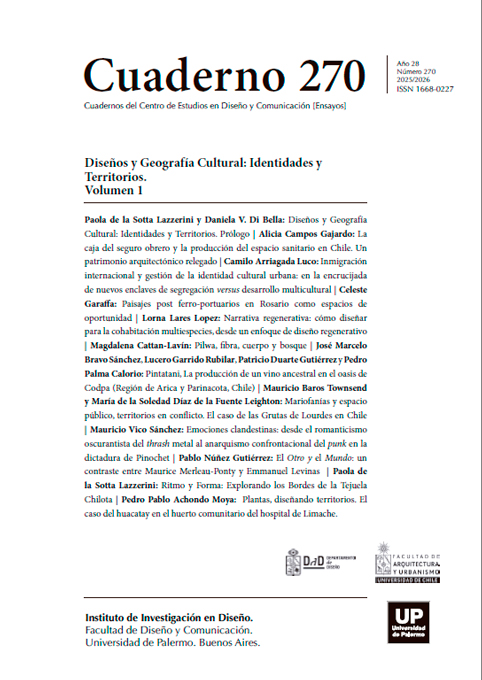Pilwa, fibra, cuerpo y bosque
Keywords:
Craft, Lafkenche
Abstract
The article explores the making of the Pilwa, a traditional craft practice deeply rooted in an artisan community’s cultural and ecological rhythms in Lago Budi.
References
Ansari, A. (2019). Decolonizing design through the perspectives of cosmological others: Arguing for an ontological turn in design research and practice. In XRDS Crossroads The ACM Magazine for Students (Vol. 26, Issue 2, p. 16). Association for Computing Machinery. (DOI: https://doi.org/10.1145/3368048)
Cappuccio, M. L. (2015). Introduction: when embodied cognition and sport psychology team-up. In Phenomenology and the Cognitive Sciences (Vol. 14, Issue 2, p. 213). Springer Nature. (DOI: https://doi.org/10.1007/s11097-015-9415-1).
Daresh, J. C. (1991). The Principalship: A Reflective Practice Perspective, 2d ed. In NASSP Bulletin (Vol. 75, Issue 535, p. 113). SAGE Publishing. (DOI: https://doi.org/10.1177/019263659107553524).
Groth, C. (2017). Making sense through hands: Design and craft practice analysed as embodied cognition. Doctoral Dissertation. Aalto University.
Cappuccio, M. L. (2015). Introduction: when embodied cognition and sport psychology team-up. In Phenomenology and the Cognitive Sciences (Vol. 14, Issue 2, p. 213). Springer Nature. (DOI: https://doi.org/10.1007/s11097-015-9415-1).
Daresh, J. C. (1991). The Principalship: A Reflective Practice Perspective, 2d ed. In NASSP Bulletin (Vol. 75, Issue 535, p. 113). SAGE Publishing. (DOI: https://doi.org/10.1177/019263659107553524).
Groth, C. (2017). Making sense through hands: Design and craft practice analysed as embodied cognition. Doctoral Dissertation. Aalto University.
Published
2025-07-02
How to Cite
Cattan-Lavín, M. (2025). Pilwa, fibra, cuerpo y bosque. Cuadernos Del Centro De Estudios De Diseño Y Comunicación, (270). https://doi.org/10.18682/cdc.vi270.12501
Section
Artículos
Los autores/as que publiquen en esta revista ceden los derechos de autor y de publicación a "Cuadernos del Centro de Estudios de Diseño y Comunicación", Aceptando el registro de su trabajo bajo una licencia de atribución de Creative Commons, que permite a terceros utilizar lo publicado siempre que de el crédito pertinente a los autores y a esta revista.


